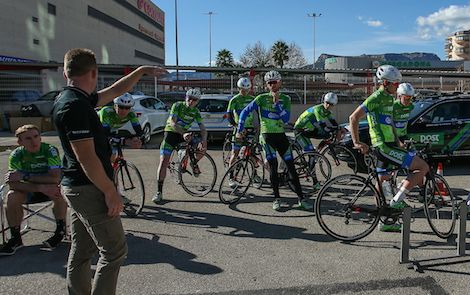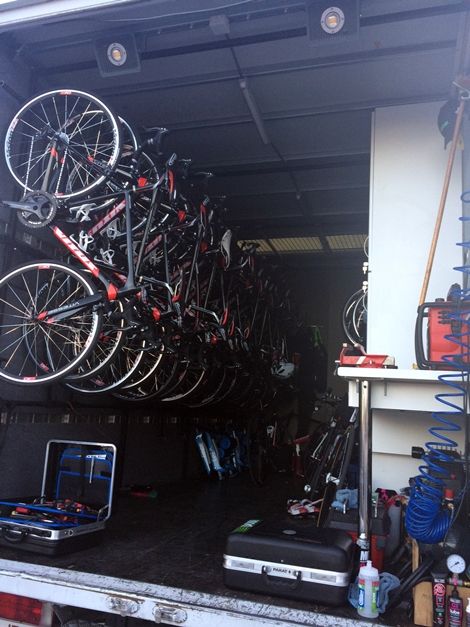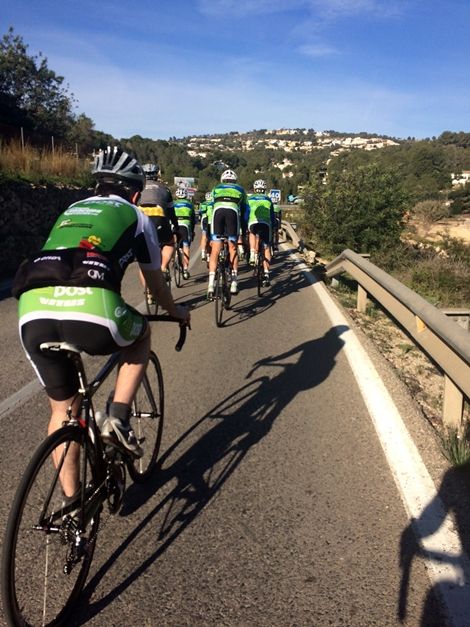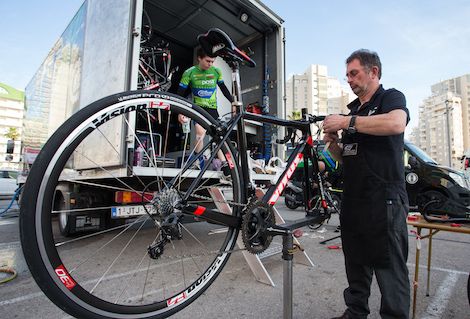The An Post-Chain Reaction are kicking off their 2016 season this weekend in Marseille, and SportsJOE got to spend a day inside their training camp in southern Spain last week.
The team, fronted by Irish cycling hero Sean Kelly, races on the UCI Europe Tour and is two tiers below the World Tour teams that typically compete in grand tours like the Tour de France but, as we soon discovered, that gap in competition does not translate into the team’s preparations.
We spoke to team general manager Kurt Bogaerts, riders Calvin Watson and Angus Fyffe and soigneur Gary Wilson at the team’s base in Calpe to see just how much work goes into a two-week preseason camp.
08:00 – The hotel breakfast buffet opens, and mechanics Bart and Freddy and soigneurs Gary and Hans are among the early risers in order to get a headstart on preparing for the day’s ride.
“We have breakfast and are straight out to the truck,” says Gary, who is on his second training camp with the team and whose son Jack is one of the team’s top riders. “In the short time I’ve been here, I’ve seen what goes on in the background, I’ve seen how busy they are and what’s required to work in a team like this. It’s labour intensive.

“We prepare bottles with everything from water to isotonic and energy drinks, we prepare all those for the riders coming down after breakfast for their ride. Some riders have different preferences, some like to start the day with an isotonic or energy drink in the first hour of their ride, some even have electrolyte tabs, it’s just personal preference but the boys seem to like them.”
The mechanics, meanwhile, are at the back of the truck unloading all the bikes and checking each rider’s equipment, delicately handling tens of thousands of euro of cycling kit each day.
The riders are eating a big breakfast to set themselves up for their ride, and with a huge variety on offer at the buffet table they are trusted to eat a balanced diet without being watched too closely.
“At the end of the day you cannot hold their hands,” sighs Kurt, although you wonder whether he ever wishes he could. “You give them the guidelines but then they need to have the strength to take what they are supposed to take.”
“At this stage everyone sort of knows you have to fuel properly,” says Angus, who will return to Queen’s University to continue his engineering degree before rejoining the squad for a summer of racing.
“There’s no point just trying to eat lettuce and then going out on the bike because it just doesn’t work. If you need to lose a bit of weight you might eat a little less but you still have to fuel properly or else you’ll struggle. So it’s a pretty big breakfast.”
09:30 – By now the riders will be out at the truck ready to collect their bikes and receive any final instructions from team boss Kurt, who will have tried to touch base with all his squad over the breakfast table.

“We have a coach at home who gives a general plan for the week and I figure out how to put it into practice,” he says.
“You look at the weather conditions and try to make a route – it’s easy these days with Strava or Google Maps. If they need to get an hour of threshold work you can split that up into three blocks, but then you need to find a longer route with three climbs for them to do their thing.”
“We meet out at the car park and then head out on the group ride for four to six hours roughly,” says Angus. ” It could change between doing shorter efforts and longer sustained efforts, but it’s usually pretty hard going. We usually come back pretty tired.
“In November you might do lower intensity efforts but longer duration, maybe 90 minutes at Zone 3, which is the pace where you’re maybe struggling to hold a conversation with the guy next to you.
“Now, closer to the season, you might do shorter efforts at higher intensity, probably 90 per cent of your max. If you’re doing a four-hour ride you might do 90 minutes at decent intensity and the rest would be endurance based.
“We’re eating constantly on the bike as well, energy bars or whatever you can handle.”
“Every day is different,” adds Calvin, an Australian rider who competed in last year’s Giro d’Italia for Trek Factory Racing.
“The training around here in Calpe is quite hilly so the rides would finish with around 3,000 metres of climbing – that’s equivalent to almost a mountain stage in a grand tour.”
When the guys do get a recovery day, which might include just a 90-minute spin, many of the riders take the opportunity to avail of the facilities at the hotel.
There is very little opportunity for down time for the backroom staff, though. While the team are out on the ride, a mechanic will follow in the team car to offer support where required, while Gary pitches in wherever he’s needed.
‘In the past few days I’ve been out with some media people, some photographers, riding the motorcycle. I have the photographer on the back for four or five hours. Sometimes I try and get out on the bike myself for a couple of hours but I have to get back to prepare the massage table and get all my stuff ready for the riders getting back.”
3:30pm – The riders return and head straight up to their rooms to shower before having a quick lunch.
“You want to be eating within half an hour or 45 minutes of coming in off the bike,” says Angus. “After that I’ll have a massage or a rub every second day. The soigneurs will massage your legs, back, or any other issue you have to get you ready for the next day. After that we can chill out and relax a bit before dinner.
“If you want to go to the gym in the hotel you can, and I try to do it at least once a week, just to keep any imbalances away that might have built up from spending so much time on the bike. At home I would do more strength-based stuff, but here I think it’s important to do a lot of stretching because you’re in a pretty aggressive position all day – with 20,000 revolutions of the pedals on a ride you can pull ligaments in your knee.”
4:00pm – With the riders safely back from their day’s work, the backroom staff kick back into action.
“The mechanics are straight into washing, cleaning and lubing the bikes in preparation for the next day,” says Gary. “The bikes are then stored back in the truck for the morning. That could take two or three hours and generally brings them up to dinner time.
“They come back, have their shower and then I would start massage from about four o’clock. Myself and Hans would each do three riders per night, about an hour with each rider. Some like a deep tissue massage, others prefer light massage, it’s all again down to riders’ preferences.”
Kurt, meanwhile, who will either have been out in the team car or else liaising with sponsors, now settles down to some of his other duties.
In addition to his role running the performance side of the team, he is involved in every aspect of the operation from PR, marketing to administration.
“After the ride I will also go through my daily emails, I am always in contact with our sponsors, many of whom have have different needs.
“You have equipment that comes in at this time of year in order for you to do the training camp, then more equipment comes in from the service centre, where mechanics are building the bikes which we will race. You must check with the organisers of the races you would like to do to build your programme, and book the flights – I’m doing a lot of the bookings myself.
“Then I try to be at lunch and check in with the team to see how the ride went if I wasn’t there, and I’ll also be at dinner – I’ll do my best to speak to every rider each day.”
6:00pm – Any media or sponsorship duties are squeezed in before dinner. For example, there is a two-hour window set aside for us to speak to the team in the hotel lobby, while the day before we meet the riders they were required to make themselves available for the team’s 2016 official launch presentation.
“After massage you might have an hour up your sleeve before dinner,” says Calvin. “These training camps are quite busy with commitments for sponsors and what not, the days tend to go by pretty quickly.”

7:00-7:30pm – The massages are done but the soigneurs can’t slow down yet. Gary and Hans are also responsible for making sure everyone’s kit is ship-shape for the following day. “We have to get their clothes ready for the next day. All the kit needs washed, dried and left out. We have washing machine and a dryer in the van.”
The riders will be down to dinner by now, which is another monstrous buffet with a cornucopia of options, including cold and hot meats and breads, omelettes, salads, pasta, fish and desserts.
“We’ll eat a fairly big meal again for training the next day,” admits Angus. “You wouldn’t want to be cutting your calorie intake at all in training camp because you are on the bike for 30 hours a week. Maybe on a rest day you’d eat a bit less.”
9:30pm – Bedtimes can vary, depending on who you are sharing a room with, but the riders benefit from a pretty relaxed attitude to lights out.
“It’s not like we have a curfew or anything,” jokes Calvin, “we’re not on school camp or anything. Most of us are all heading to bed after dinner and watching some TV before getting to sleep.”
“I’m with Damien Shaw and he doesn’t like to switch the lights off until 11ish,” says Angus. “But he’s the Irish champ so I can’t really argue with him, he knows what to do. I try to get a good solid eight or nine hours in, but everyone’s different. Some guys could sleep up 14 hours if they could.”
With the riders adjourning for the evening, Kurt leads a meeting of the team’s staff to get updates and plan out the following day’s activities.
“Every night we all sit together and plan out what we are going to do the next day in terms of training, and then we also talk about plans for future races and programmes for the team. The soigneurs are a really good guide to how the riders are handling the training,” he says.
It is the Belgian who sets the tone for the camp and he is determined that, despite their status as a Continental team, his riders will go into each of their races with the same standard of preparation and equipment as the other teams on the startline.
“It’s very important that the riders are treated very well,” he states. “We are competing in international races with riders who are well looked after so if we don’t look after ours then they are at a disadvantage and you will lose the battle.
“You need the best equipment, really good nutrition, everything needs to be at the standard of a pro tour team and that is the battle that Sean and I are fighting constantly with the sponsors. We want the best so we can go into battle with the best.

And those efforts do not go unnoticed by the riders, particularly Calvin, who is coming to the team having experienced life at World Tour level, where financial budgets dwarf those available to An Post-Chain Reaction.
“Kurt and Sean run a really tight squad,” the 22-year-old reports. “I’ve been quite impressed by the team and how it’s run.
“To be honest, being at the training camp almost feels like being at a race. You’re at a hotel setting, eating from a buffet like at a race, and the only thing different is that you have a number on your back. Otherwise you go through all the things you would on race day, the recovery, the massage, it’s quite similar.”
Nonetheless, as the group comes to the end of its fortnight together in Calpe, everyone is eagerly looking forward to leaving the cycling bubble for a while before starting the season proper.
“You’re enclosed to the whole cycling scene, there are six teams staying here so there’s not really anywhere to escape to,” adds Calvin.
“It’s nice to be here with the team and be around the guys but come the end of two weeks I’m looking forward to getting home and back to a normal day-to-day routine.”














































